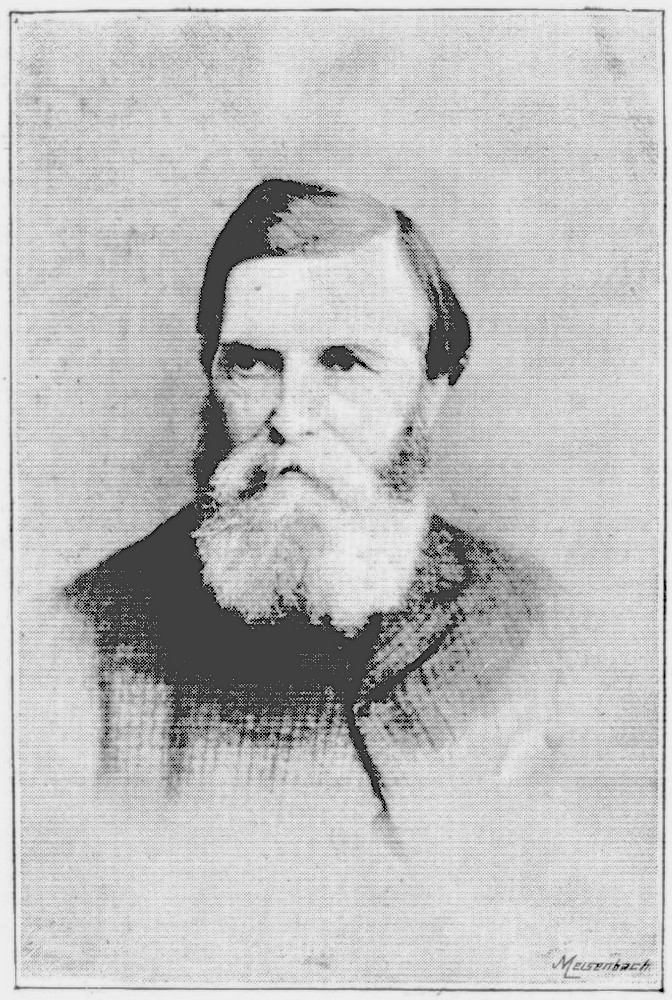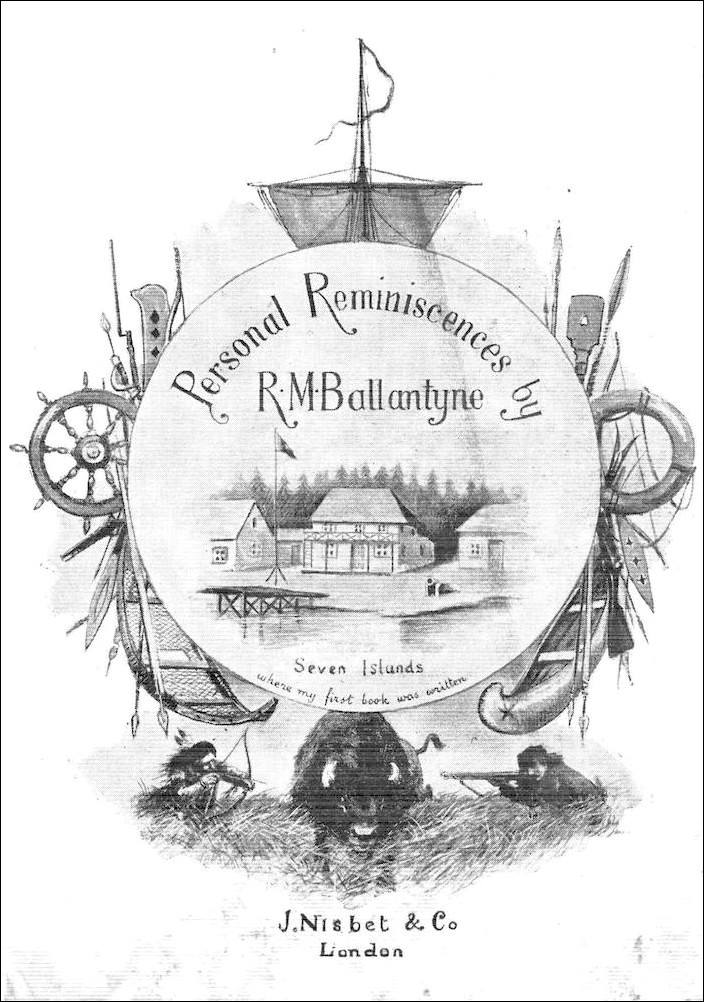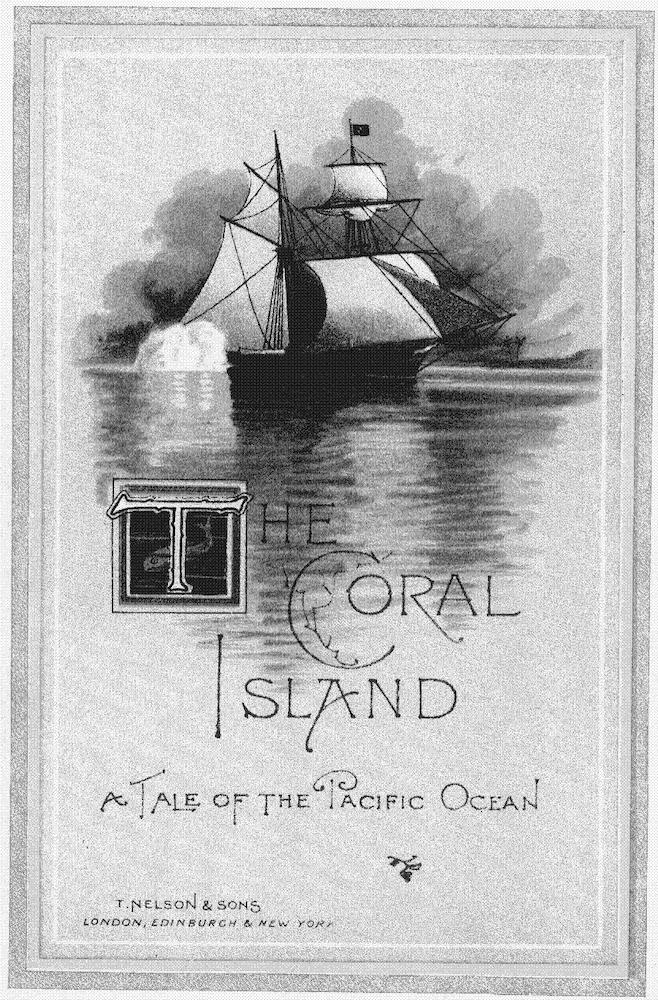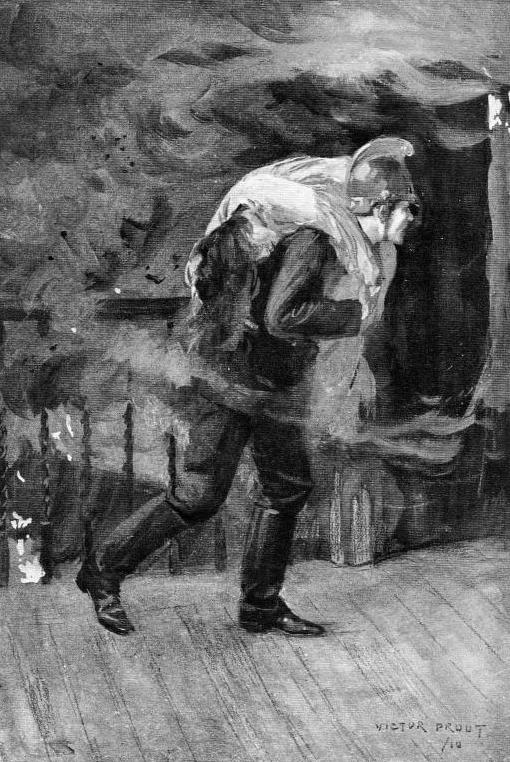
1825 24 April, Robert Michael Ballantyne born in Edinburgh, Scotland, to Anne Randall Scott Grant and Alexander Ballantyne, a newspaper editor.
1835 – 1837 Educated at Edinburgh Academy.
1841 – 1847 Employed as a clerk for the Hudson's Bay Company in Canada. In his 1893 work, Personal Reminiscences in Book-Making, Ballantyne described his life there:
My comrades and I spent the greater part of our time in fur-trading with the Red Indians; doing a little office-work, and in much canoeing, boating, fishing, shooting, wishing, and skylarking. It was a "jolly" life, no doubt, while it lasted, but not elevating! [5]
He went on to credit his writing ability to the long letters he wrote his mother while overseas.
With a winter of eight months' duration and temperature sometimes at 50 below zero of Fahrenheit, little to do and nothing particular to think of, time occasionally hung heavy on our hands. With a view to lighten it a little, I began to write long and elaborate letters to a loving mother whom I had left behind me in Scotland. The fact that these letters could be despatched only twice in the year was immaterial. Whenever I felt a touch of home-sickness, and at frequent intervals, I got out my sheet of the largest-sized narrow-ruled imperial paper—I think it was called "imperial" — and entered into spiritual intercourse with "Home." To this long-letter writing I attribute whatever small amount of facility in composition I may have acquired. Yet not the faintest idea of story-writing crossed the clear sky of my unliterary imagination. I am not conscious of having had, at that time, a love for writing in any form—very much the reverse! [6-7]

1847 At the suggestion of a family friend, Ballantyne publishes the letters he wrote home in a book entitled Hudson's Bay. He also gives lectures in Edinburgh about his time in Canada, enlivening the talks by dressing as a backwoodsman, telling dramatic stories, and showcasing a collection of Canadian souvenirs.
1847-1849 Employed as a clerk for the North British Railway Company in Edinburgh.
1849 After the death of his sister, Ballantyne becomes fervently religious, and is elected an elder of the Free Church of Scotland.
1849-1855 Becomes a junior partner at the printing-house Thomas Constable and Company.
1854 Ballantyne is approached by William Nelson and asked if he would like to take up a literary career, and suggests that he commences with a story. Ballantyne agrees.
1855 Snowflakes and Sunbeams; or, The Young Fur-Traders is published.
1856 Ungava: A Tale of Eskimo-Land published.

1857 The Coral Island, Ballantyne's most popular work, is published. In Personal Reminiscences, he wrote:
…while studying up for The Coral Island, I fell into a blunder through ignorance in regard to a familiar fruit. I was under the impression that cocoa-nuts grew on their trees in the same form as that in which they are usually presented to us in grocers' windows — namely, about the size of a large fist with three spots, suggestive of a monkey's face, at one end. Learning from trustworthy books that at a certain stage of development the nut contains a delicious beverage like lemonade, I sent one of my heroes up a tree for a nut, through the shell of which he bored a hole with a penknife and drank the "lemonade"! It was not till long after the story was published that my own brother — who had voyaged in Southern seas — wrote to draw my attention to the fact that the cocoa-nut is nearly as large as a man's head, and its outer husk over an inch thick, so that no ordinary penknife could bore to its interior! Of course I should have known this, and, perhaps, should be ashamed of my ignorance — but, somehow, I'm not! [13]
…Recognising, then, the difficulties of my position, I formed the resolution always to visit — when possible — the scenes in which my stories were laid, converse with the people who, under modification, were to form the dramatis personae of the tales, and, generally, to obtain information in each case, as far as lay in my power, from the fountain-head. [15]
1860 July Ballantyne is made Captain of the No. 9 Company of the Edinburgh Rifle Volunteers, which he serves in this position for 3 years.
1863 In search of material for his next book, The Lifeboat, R.M. Ballantyne explained that "went to Ramsgate, and, for some time, was hand and glove with Jarman, the heroic coxswain of the Ramsgate boat, a lion-like as well as lion-hearted man, who rescued hundreds of lives from the fatal Goodwin Sands during his career" (Personal Reminiscences, 15).
1865 Ballantyne spent three weeks at the Bell Rock Lighthouse, where he "hobnobbed with the three keepers of that celebrated pillar-in-the-sea for three weeks, and read Stevenson's graphic account of the building of the structure in the library, or visitor's room, just under the lantern" (Personal Reminiscences, 15). The experience and the stories he collected were used in his novel published later that year, The Lighthouse.

1866 Ballantyne marries Jane Dickson Grant
1867 In the spring of the year, Ballantyne spent several weeks at a London fire-station by permission of Captain Shaw, Chief of the London Fire Brigade, to collect material for a new book, Fighting the Flames. Several scenes in this novel are taken directly from life, as they are related as true stories in Personal Reminiscences.
1868 For his next book, Deep Down, Ballantyne and his wife spent "… three months … in the town of Saint Just, close to the Land's End, during which time [he] visited some of the principal mines in Cornwall; associated with the managers, "captains," and miners, and tried [his] best to become acquainted with the circumstances of the people" (Personal Reminiscences, 74).
1869 Erling the Bold published. This book was the result of Ballantyne's several excursions to Norway.
1874 The Pirate City published. Ballantyne spent a winter in Algiers collecting material, and received information from the Consul-General to Algiers regarding various historical events and other necessary details.
1883 Moved to Harrow, Middlesex
1884 The Young Trawler published.
1889 Blown to Bits is published, a story of the 1883 Krakatoa explosion.
1893 Personal Reminiscences in Book-Making is published. It contains descriptions of his travels and adventures in search of material for his novels, as well as a couple of short stories at the end.
1894 8 February, Ballantyne dies in Rome, Italy of Ménière's Disease. He is buried in the Protestant Cemetery of Rome. After his death, a subscription was held for a tombstone to be erected in his memory, and many of the donations came from schoolboys who had read and loved his books.
Bibliography
Ballantyne, R.M. Coral Island. London and New York: Nelson. 1897. Internet Archive. Web. 1 October 2025. [Source of title page.]
_____. Fighting the Flames. London: Ward Lock, 1867. Internet Archive. Web. 1 October 2025. [Source of illustration.]
_____. Personal Reminiscences in Book-Making. London: James Nisbet & Co., 1893. Internet Archive. Web. 1 October 2025. [Source of frontispiece portrait and title page illustrations.]
Liukkonen, Petri; Pesonen, Ari. "R.M. Ballantyne (1825-1894)." Authorscalendar.info. Web. 1 October 2025. http://authorscalendar.info/ballant.htm.
Quayle, Eric. Ballantyne the Brave; A Victorian Writer and His Family. Chester Springs: Dufour Editions, Inc., 1967.
Created 1 October 2025